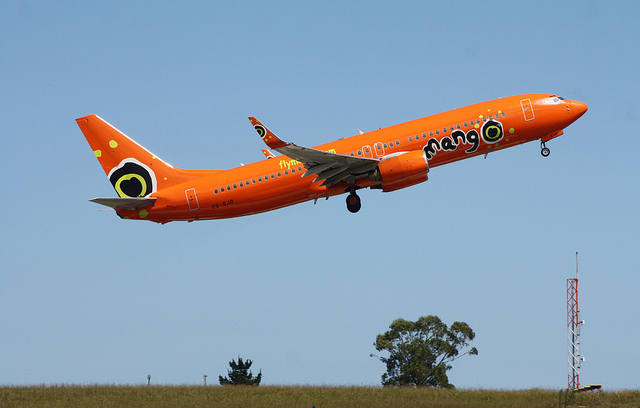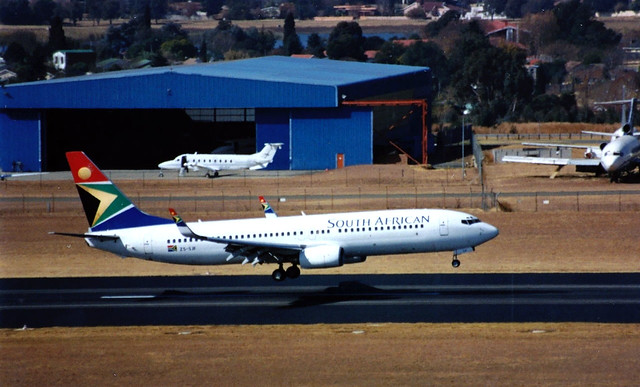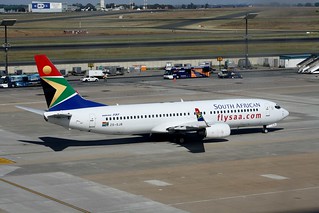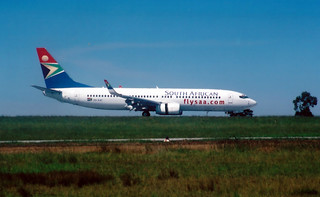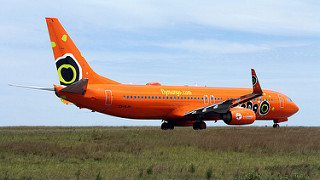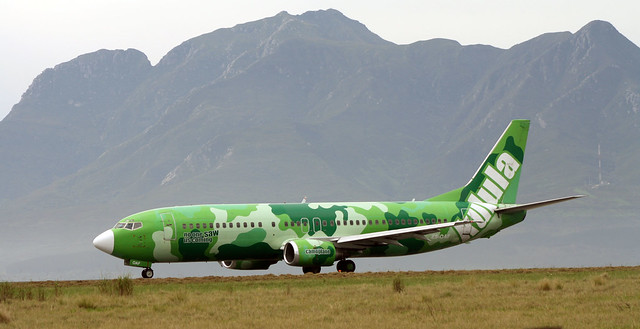Mango B738 at Johannesburg on Sep 2nd 2019, electrical and manual trim problems
Last Update: December 5, 2020 / 16:00:09 GMT/Zulu time
Incident Facts
Date of incident
Sep 2, 2019
Classification
Incident
Airline
Mango Airlines
Flight number
JE-129
Departure
Johannesburg, South Africa
Destination
Cape Town, South Africa
Aircraft Registration
ZS-SJD
Aircraft Type
Boeing 737-800
ICAO Type Designator
B738
The South African Civil Aviation Authority (SACAA) reported the captain (43, ATPL, 12,345 hours total, 3,696 hours on type) was assisted by a first officer (29, ATPL, 2,592 hours total, 1,888 hours on type). The aircraft had undergone various maintenance activities between May 22nd 2019 and Jul 26th 2019 due to a flight crew report the aircraft had started oscillating in flight. On Aug 5th 2019 the electrical trim motor was removed from the airframe and used on another airframe. On Aug 7th 2019 another trim motor, the service history of which so far could not be determined, was installed on the airframe.
On Oct 22nd 2019 the SACAA issued a statement reading (editorial note: it remains unclear whether this is related to the trim motor without determined service history mentioned above or not, a number of South African Media had speculated about fake parts being discovered prompting a statement released by South African Airways Technical on Oct 10th 2019 that no fake parts had been used):
The South African Civil Aviation Authority (SACAA) can confirm that as part of its day-to-day aviation safety and security oversight activities, it most recently, conducted an inspection at South African Airways Technical (SAAT), an approved aircraft maintenance organisation.
During the audit, the SACAA sampled a few aircraft, which were subsequently issued with a prohibition order, meaning these aircraft could not operate until such time they had addressed the non-compliances.
South African Airways Technical has since submitted a Corrective Action Plan (CAP) to the SACAA aimed at addressing the irregularities. The Corrective Action Plan was found to be acceptable by the SACAA.
The SACAA has been in communication with the concerned approval-holders, i.e. South African Airways Technical, Mango, Comair and South African Airways, and directed them to conduct a verification exercise on their fleet to ensure that the identified irregularities were not prevalent in the entire fleet.
If any of the aircraft is deemed not to be safe to fly, then the operator is expected to correct any non-conformities and ensure that the affected aircraft are not flown before the necessary corrective measures are undertaken.
The SACAA has since noted that operators have taken precautionary measures and undertaken what is normally referred to as ‘self-grounding’, to enable them to conduct verification that their aircraft are safe to fly. The airlines are expected to provide assurance to the Regulator that all aircraft that are released back to service meet the regulatory requirements.
The SACAA appreciates the seriousness by which the airlines have taken the concerns and believes this cooperation goes a long way in ensuring continued safety and security of civil aviation in South Africa.
ON Dec 5th 2020 the SACAA released their final report concluding the probable cause of the incident was:
Whilst levelling off at top of climb, the elevator continued to move in the nose up direction without the stabiliser moving in unison, causing the “stab out of trim” light to illuminate. After the crew had disconnected the autopilot, the elevator moved further to a nose up position (original position) in response to the manual column input. The cause of the stab trim not moving with the elevator could not be determined as all tests conducted on the system came out satisfactory.
The SACAA analysed:
During levelling off at FL360, the stab out of trim warning light illuminated in the cockpit and remained on. The crew then referenced and followed the QRH instructions and disengaged the autopilot. Following the disengagement of the autopilot, the crew noticed that there was a significant out of trim on the flight controls with limited manual trim control, and the aircraft had a nose-dive attitude. The crew controlled the horizontal stabiliser trimming manually using the trim wheel.
The cause of the significant out of trim condition was likely due to the horizontal stabiliser that was not supplying long-term pitch control of the aircraft at TOC when the elevators were moved (nose up), consistent with the QAR data. The cause of the horizontal stabiliser not moving with the elevator trim could not be established as all horizontal stabiliser and elevator systems were checked and no fault was found. The aircraft was controllable after the crew had disengaged the autopilot and had overrode the trim switches, but the electrical system of the horizontal stabiliser trim was still unresponsive.
When manually trimming the horizontal stabiliser, the trim wheel jumps back to its original position. It is likely that during the electrical trimming, the stab trim cut out switch was not selected to the “off” position. More force had to be applied (exerted) to achieve manual trimming.
The AMO conducted vigorous troubleshooting IAW AMM. The recorded faults on the MCDU were reviewed which resulted in the LRU change. There were no faults found on the gears/sprocket and chain. The chain play was measured and found to be within limits at 7.9mm; the cable tension was checked and was found to be within limits at 122 pounds.
The removed stab trim motor (STM) (S/N: 3680) was sent to the OEM for testing and there were no faults found. The cause of the stab out of trim was inconclusive as there were no other warnings in the cockpit prior to stab out of trim warning and the only LRU that was changed was the STM. All related system components (AFCS, flight control cables and functional checks) were satisfactory.
Since installation of STM (S/N: 6246), no further defects were reported, and the aircraft was released back to service.
The SACAA analysed the management:
The operator had processes and procedures in place for cannibalisation of STM between the fleet.
The installation and interchangeability of STMs which had no traceability record became a standard practise for the AMO and the operator. Although the STM had an FAA authorised release certificate (form 8130-3) and certificate of conformity and material certification form, the TSN, TSO, TSI and TST were unknown. These units were removed from the affected aircraft. The lack of tracking of hours of STM S/N: 3680 made it difficult for the investigators to make conclusions regarding the reliability and failure rate of this component. The operator had reliability stats programme for the fleet available.
It was discovered that the previous part numbers were susceptible to primary failure of the solder joint fatigue crack of the non-volatile memory (NVM) chip due to a combination of uncontrolled environment conditions, causing bending, vibration and thermal expansion stresses. The STM in question was not a factor in this case as there were no faults found during testing. A fleet inspection was carried out by the operator following the incident and it was discovered that there were three STMs that were not modified to status level 9 and they were removed from the affected aircraft on the operator’s fleet (ZS-SJO with STM S/N: 1248, ZS-SJC with STM S/N: 4573 and ZS-SJA with STM S/N: 3329). These STMs were scheduled to be sent to the OEM for modification status level 9 embodiment IAW the service letter during Quarter 1 of 2020 and Quarter 3 of 2020.
Incident Facts
Date of incident
Sep 2, 2019
Classification
Incident
Airline
Mango Airlines
Flight number
JE-129
Departure
Johannesburg, South Africa
Destination
Cape Town, South Africa
Aircraft Registration
ZS-SJD
Aircraft Type
Boeing 737-800
ICAO Type Designator
B738
This article is published under license from Avherald.com. © of text by Avherald.com.
Article source
You can read 2 more free articles without a subscription.
Subscribe now and continue reading without any limits!
Read unlimited articles and receive our daily update briefing. Gain better insights into what is happening in commercial aviation safety.
Send tip
Support AeroInside by sending a small tip amount.
Related articles
Mango B738 at Cape Town on Apr 9th 2017, bird strike
A Mango Boeing 737-800, registration ZS-SJD performing flight JE-348 from Cape Town to Durban (South Africa), was climbing out of Cape Town's runway…
Mango B738 enroute on Jan 25th 2021, loss of cabin pressure
A Mango Airlines Boeing 737-800, registration ZS-SJF performing flight JE-251 from Johannesburg to Durban (South Africa) with 117 passengers and 6…
Mango B738 at Durban on Jul 14th 2020, turbulence injures flight attendant
A Mango Boeing 737-800, registration ZS-SJB performing flight JE-261 from Johannesburg to Durban (South Africa) with 117 people on board, was…
Mango B738 at Cape Town on Jan 14th 2020, dropped fairing panel
A Mango Boeing 737-800, registration ZS-SJC performing flight JE-152 from Cape Town to Johannesburg (South Africa), was climbing through about 9000…
Mango B738 at Johannesburg on Nov 19th 2017, bird strike
A Mango Boeing 737-800, registration ZS-SJH performing flight JE-147 from Johannesburg to Cape Town (South Africa) with 179 people on board, was…
Newest articles
Mauritius AT72 anear Rodrigues Island on Nov 11th 2025, cracked windshield
An Air Mauritius Avions de Transport Regional ATR-72-212A, registration 3B-NCV performing flight MK-141 from Rodrigues Island to Mauritius…
Safair B734 and France B773 at Johannesburg on Oct 17th 2025, cleared to land on occupied runway
A Safair Boeing 737-400, registration ZS-OAF performing flight FA-249 from East London to Johannesburg (South Africa), was on an ILS approach to…
Subscribe today
Are you researching aviation incidents? Get access to AeroInside Insights, unlimited read access and receive the daily newsletter.
Pick your plan and subscribePartner

ELITE Simulation Solutions is a leading global provider of Flight Simulation Training Devices, IFR training software as well as flight controls and related services. Find out more.
SafetyScan Pro provides streamlined access to thousands of aviation accident reports. Tailored for your safety management efforts. Book your demo today
AeroInside Blog
Popular aircraft
Airbus A320Boeing 737-800
Boeing 737-800 MAX
Popular airlines
American AirlinesUnited
Delta
Air Canada
Lufthansa
British Airways

